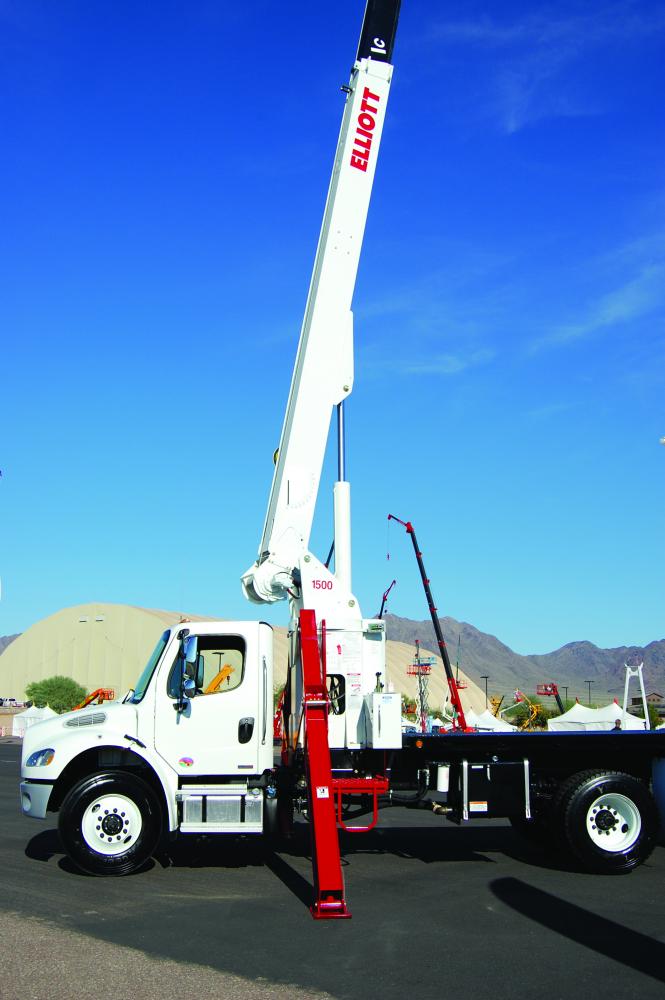
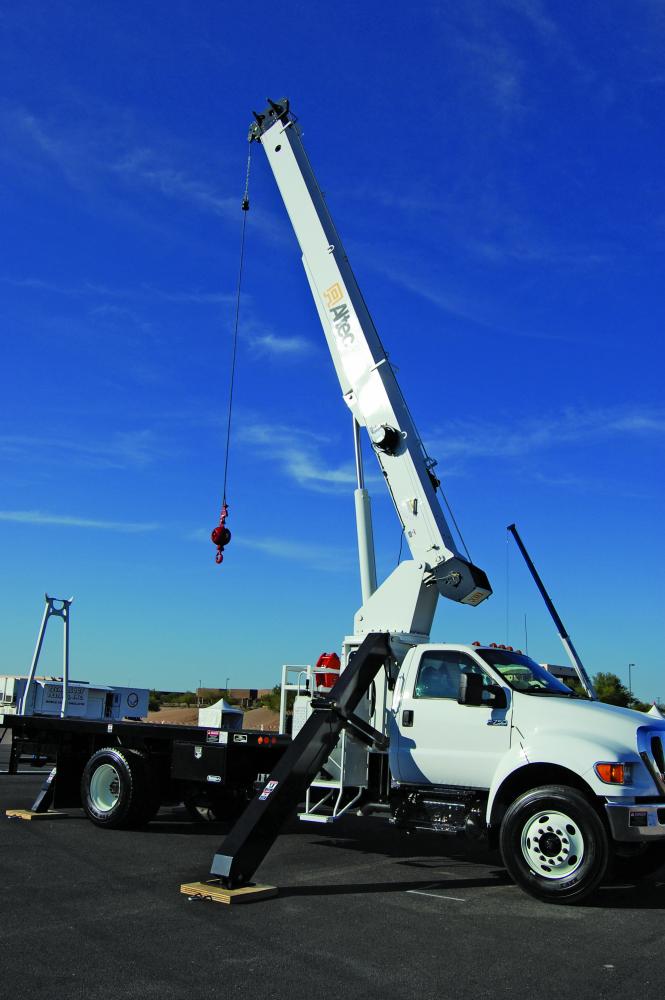
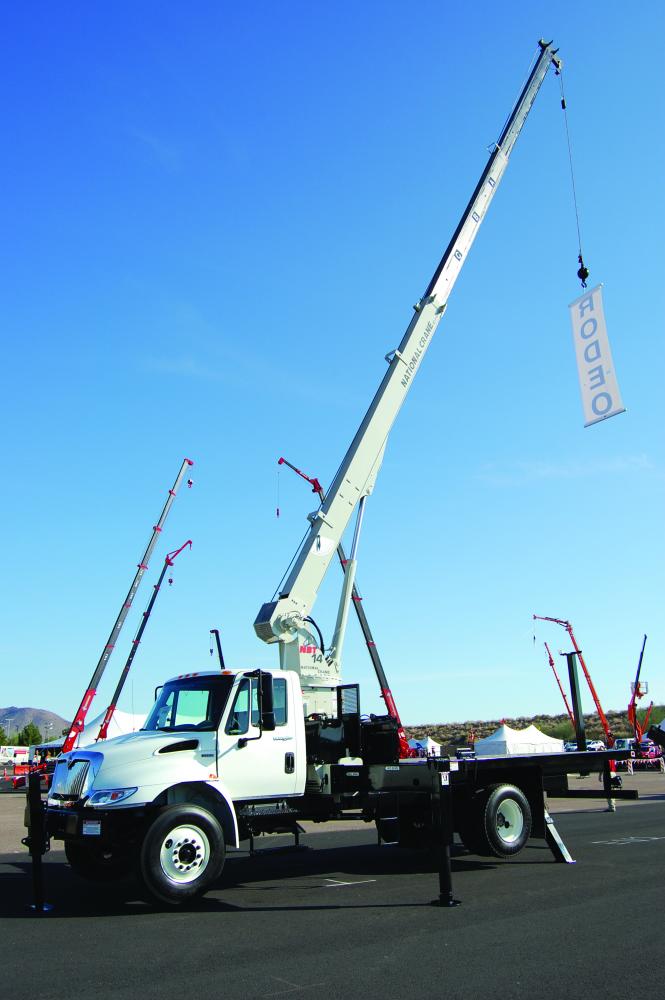
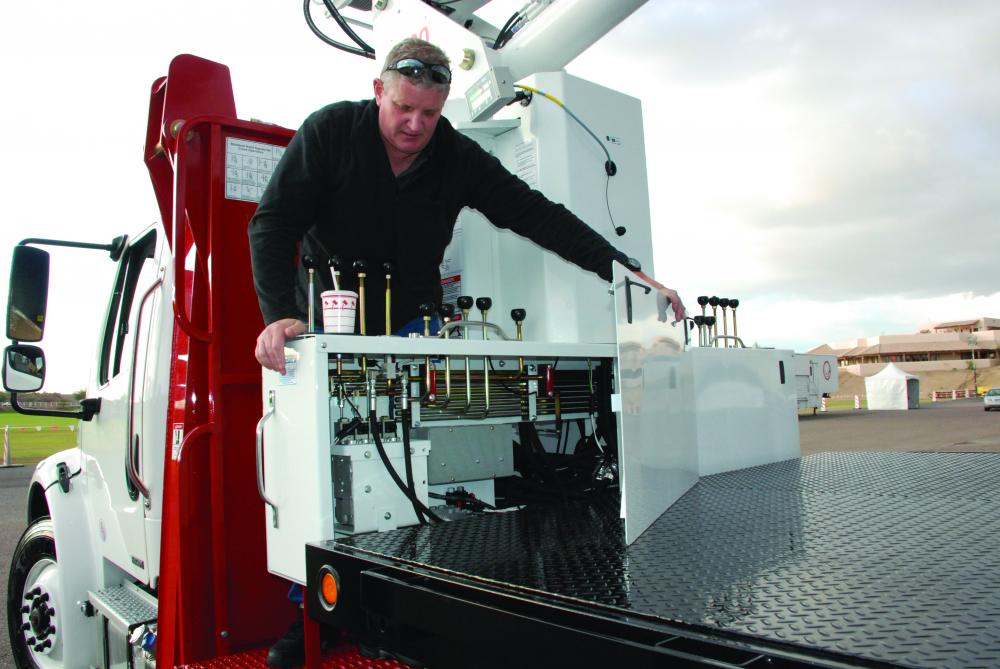

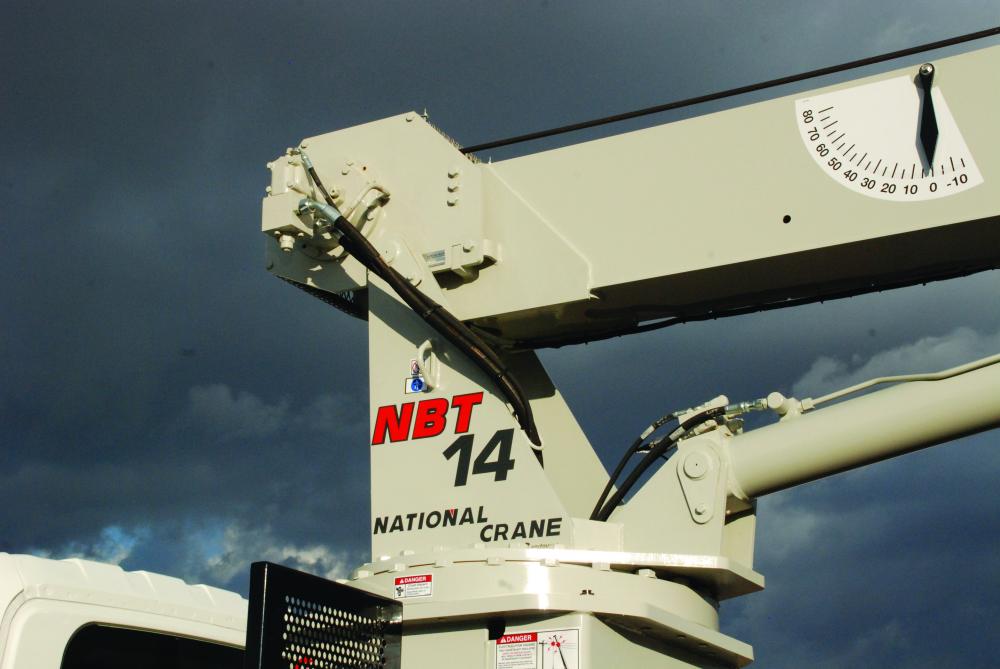
For many manufacturers, boom trucks in the under 18-ton class were among the first models they introduced, dating back to the 1960s. Representatives at the Lift and Access Showcase & Symposium Q&A discussion agreed that there’s not a lot of profit margin in the small boom truck, but it’s a machine that they feel they must have in their product line. Despite a bare-bones mentality, there were significant design differences among the three models reviewed at the Showcase, held in Scottsdale, Ariz., last November.
Of the three, National’s NBT14 is both the newest and comes with the most history. “Over the years our smaller boom trucks have evolved into bigger machines as upgrades were made to increase capacity and improve performance,” said Brian Peretin, Manitowoc’s vice president of sales and product marketing for boom trucks in North America. “This created a gap in our product line between the 10-ton 400B and 18-ton 500E2.” Rated at 14 tons, the NBT14 fills that spot in the company’s product line. Making its debut at the Showcase, the prototype design represents a “return to our roots for the rental market. Although they remain very price-sensitive, customers are asking for this,” said Peretin.
At 15 tons, Elliott’s 1560F in its Showcase configuration is closer in size to the NBT14 than Altec’s 18-ton AC18-70B. Both the Elliott and National cranes featured 60-foot, three-section booms. However, the 1560F can also be rated at 18 tons. “It can carry an 18-ton rating if you put it on a truck with a 12,000-pound front axle with a 60- or 70-foot boom,” said Schneider.
What sets Elliott apart is that the manufacturer is known for customizing its products, making it possible for customers to select any number of boom lengths (three- to five-section ranging from 38 to 81 feet), three outrigger styles, and other options. The unit on display at the Showcase was built for a typical rental application. “As a rental machine goes, it has to be rugged; it has to be light; it has to be cost effective,” said Schneider.
Introduced in 2006, Altec’s AC18-70B, with a 70-foot, three-section boom, is designed for “safety, productivity, operator convenience, and serviceability,” said Matt Trefz, market manager for Altec Cranes, Daleville, Va. The company has focused on making most set-up tasks possible to perform from the ground, thereby reducing the number of times an operator has to climb on and off the bed by as much as 50 percent compared to other cranes. “All the setup can be done from the ground before you access the crane controls. The reason we do this is that the most common accident at a crane site is slip, trip, and fall. The fewer times the operator has to access the crane controls and come back down, the safer the product is,” said Trefz.
When it is necessary to access the crane controls, Altec provides steps rather than a ladder. Even at the rear, access to the bed is from an angled ladder. “This is more like climbing a stair and there are three points of contact,” said Trefz.
Ready for the road
Of the three cranes displayed, only National’s NTB14 was truly a non-CDL version. Mounted on an International DuraStar 4300 chassis with 26,000 pounds GVW and hydraulic brakes, this small package does not require the driver to have a commercial license. According to Ryan Moose, senior engineer, the company is also developing two other models in this family. A 15-ton model with a 33,000-pound GVW chassis and 16-ton model with 48,000-pound GVW will further fill the company’s product line below its 18-ton 500E2.
Elliott’s custom 1560F barely missed the requirements for non-CDL, but only because this was not important to the customer for whom it was built, a municipality located on the West Coast. Mounted on an M2 Freightliner, the crane had less than 10,000 pounds on the front axle and 17,000 pounds on the rear. The heavier weight was due primarily to the customer’s request for a heavy-duty Omaha Standard steel bed with a structural steel chain rail. The bed weighed 3,700 pounds. In addition, the truck was equipped with steel wheels at the customer’s request. Even in this heavier configuration, the truck still had 2,000 pounds of payload capacity on the bed.
“To get this under CDL, all we need is a lighter bed. We could even add a 70-foot boom and make it work,” said Schneider. “From a pure rental standpoint, this is a cost-effective package. There’s a challenge to putting a crane this size on a small truck like this, but that’s what we do—customize the fit-up,” he said.
The Altec AC18-70B was mounted on a 33,000-pound GVW Ford F-750XL Super Duty chassis.
Controls and safety features
All three cranes feature traditional stand-up stationary control stations for the crane operator, but each manufacturer presents a different take on the style of controls. Elliott offers four manual, single-axis control levers, and Altec utilizes pilot-operated joysticks. Both Elliott and Altec offer radio-remote control as an option, but National makes a complete departure from the norm with radio-remote control as standard.
“We’ve eliminated some electronics on this machine in order to improve the reliability out in the field,” said Elliott’s Glazer. Both a foot throttle and thumb throttle are available. As for the radio-remote option, it’s not often selected for rental applications, explained Schneider, because “in the field they lose them or break them or the battery runs out.” The Elliott unit on display at the Showcase, however, was equipped with radio-remote control at the customer’s request.
“These controls are intuitive in the sense that when you move the lever the way you want the machine to swing, it swings that way,” said Trefz of Altec. In addition, an optional winch drum rotation indicator provides tactile feedback in the joystick handle for times when the operator can’t see the load, “such as behind a wall or when below grade,” he said.
With the new design of the NBT14, National selected radio-remote control because “it has allowed us to do more with the controls than ever before. For example, full engine throttle control, sensor information, and error codes are all available to the operator,” said Moose. The control resides in a docking station at the operator console, or is portable to give the operator better visibility of the load or the outriggers when setting up the crane. For rental customers, the remote control can be locked into the docking station to prevent it from getting lost or even hard-wired, if the customer prefers, explained Moose. All crane functions reside on the radio-remote control, which is supplied by NBB Controls. The controller also features an operative display which provides utilization information such as boom length and angle, outrigger position, and percent of crane capacity used.
Altec offers its rated capacity limiter—the LMAP Load Moment and Area Protection device—as standard. It also displays boom length and angle, load on hook, and percent of rated capacity.
National and Elliott provide load moment indicators as options. On the NBT14, a Hirschmann Mentor QVGA load moment indicator comes with work area definition. In addition, Manitowoc offers a Hydraulic Capacity Alert System (HCAS) that locks the machine out when lift cylinder pressure corresponding to an overload condition is reached. The LMI and HCAS interface with the remote control to give the operator information. The Elliott boom truck displayed at the Showcase was equipped with an optional Greer Microguard 586 load moment indicator. In the near future, Greer will discontinue that model, and Elliott plans to offer the Greer Insight instead.
Outriggers and setup
Before ever accessing the Altec boom truck’s operator station, the operator can use outrigger controls and lower winch controls located on the ground at the rear of the crane. “The controls are placed here so the operator can see the shoes as they contact the ground and that eliminates a potential crush hazard for ground personnel,” said Trefz. The exception to this is if the crane is equipped with an optional front bumper outrigger and accompanying 360° load chart. In that case, the outrigger controls are positioned at the front bumper. Elliott’s outrigger controls are on the operator console, and National’s reside on the remote control. Front bumper outriggers are also optional for the Elliott and National models. The NBT14’s optional front bumper outrigger automatically retracts before the main outriggers so the operator doesn’t have to remember to raise it before moving the truck.
Altec features A-frame outriggers on the AC18-70B. The Showcase unit displayed by Elliott also had A-frame outriggers, but the company offers several other options, including out-and-down outriggers or a proprietary SuperLink A-frame design, which allows short-jacking. When so equipped, crane operation is controlled by a work area definition system that prevents operation on the side of the crane where outriggers are not extended.
Meanwhile, the National NBT14 is equipped with out-and-down front outriggers more commonly found on larger cranes. The boom truck features load charts for full, mid, and retracted extension. The rear outriggers are A-frame type.
Reliable, dependable performance
While the NBT14 is as yet unproven, it is currently undergoing field testing as part of Manitowoc’s Pre-Production Partner program. Working with customers and dealers, pre-production units are put into service for about six months before production actually begins while Manitowoc conducts in-field testing and customers provide feedback about the performance of the machine. Production is planned to begin in early 2013.
Elliott Equipment also values reliability, offering a lifetime structural warranty for the 1560F, as it does with all its products. “When we talk about durability and reliability of our machine, we stand behind it with our warranty,” said Glazer. He further explained that Elliott uses an independent provider for all of its product testing. “They hold us to much more rigorous standards than if we did it in-house,” he said.
When repairs do need to be made, it’s easy to access the brains of the crane. “One of the nice things about this particular machine, is you can get right inside your console, so if you have wiring issues or problems with the remote control, it takes just 15 seconds to get right at it. From a serviceability standpoint, sometimes it isn’t quite as easy as that [on other equipment],” said Schneider.
To aid the operator and the mechanic, Altec posts schematics and hydraulic diagrams around the crane to assist with troubleshooting. “Additionally we put decals where helpful, such as on the hydraulic reservoir indicating how to access the filter, what the parts numbers are, etc. That’s also true for the breather filter,” said Trefz. Inside the cab of the truck is a description of the crane-chassis interface.
As for reliability, “all of the major weldments on this machine are manufactured in Roanoke, Va. We bring the steel in there, cut it with lasers, form it, weld it, machine it, and then two-stage powder paint finish. That extremely robust finish will last the lifetime of the crane,” he said. Additionally, many of the sensors, such as for the outrigger interlock switch and winch drum rotation indicator, are non-mechanical. “There are no moving parts, so it’s not a wear item,” said Trefz.
Other key stats
All three manufacturers offer optional jibs and personnel platform attachments to increase machine versatility. Elliott also offers clamshell and fork attachments. National offers a frame-mounted boom rest available for tractor-mount applications or to keep the rear of the bed open on standard-mount cranes. A removable boom rest at the rear of the deck is standard. “We also have less hoist tailswing on this model, which helps out when people have racks on their trucks or might be hauling things close to the hoist,” Moose said of the National crane.
Operator convenience items include a cellphone charger and cup holder at the operator console on the Elliott 1560F. Engine start/stop is standard at the Altec AC18-70B console for situations where idling must be kept to a minimum. “This eliminates the operator having to climb inside the truck cab to restart the engine,” said Trefz. Altec also offers vertical block and ball storage. In National’s integration of the radio-remote, the operator station is not in one set place, so it’s crucial all information be provided to the operator at the remote. This includes everything from low fuel level alerts to error codes. Service technicians can connect to the control module via USB for additional diagnostic capabilities.
Finally, line pull and capacities are worth comparing. Elliott supplies 275 feet of 9/16" wire rope with a single-line pull of 9,600 pounds. With the same wire rope, National offers a 7,700-pound line pull. The Altec crane can be fitted with 9/16" or rotation-resistant wire rope for a single-line pull of 10,571 pounds or 7,400 pounds, respectively.
The NBT14 t has a capacity of 5,150 pounds at a 30-foot radius. At the same radius, the Elliott 1560F can lift 6,600 pounds, and the Altec AC18-70B is good for 6,800 pounds.